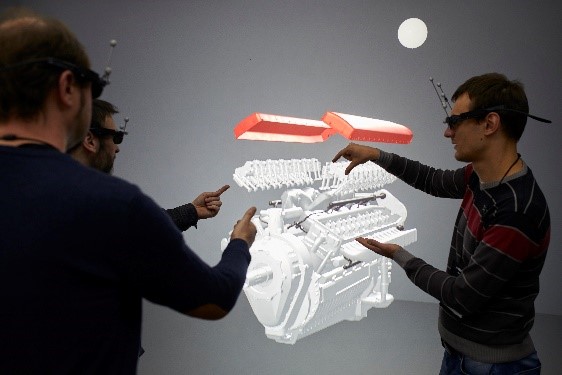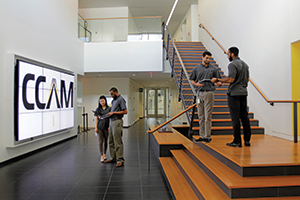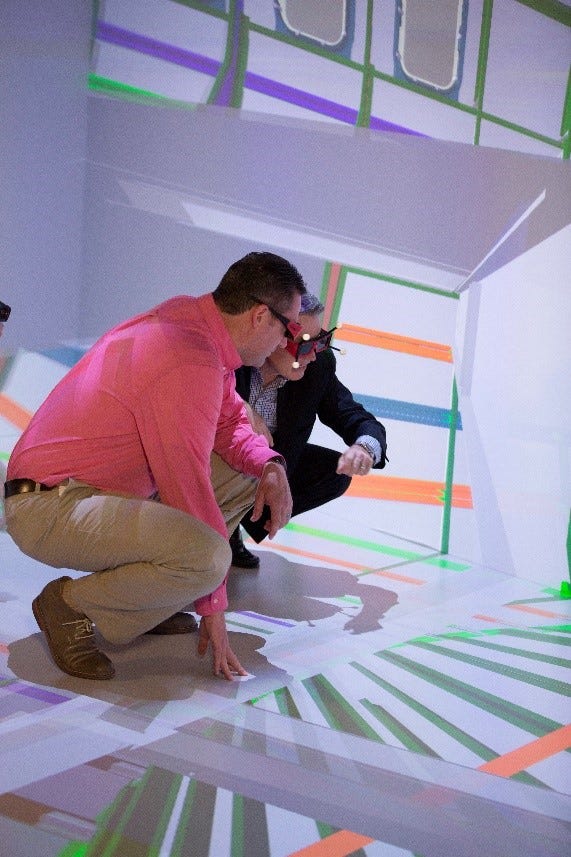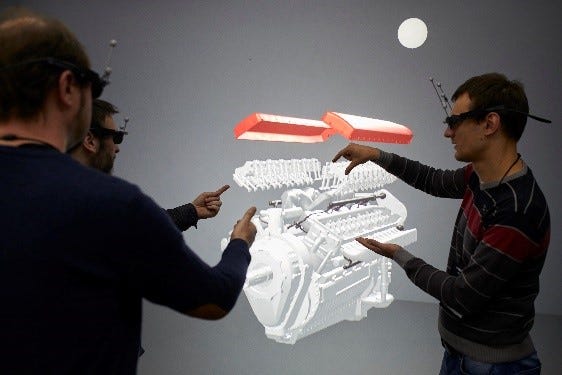VR and AR Tools Provide Improved Products, Faster Production, and Lower Costs
For manufacturers, using VR visualizations reduces the cost and time of developing physical prototypes, and drives down the cost of rework due to design errors.
September 3, 2019

The idea of using virtual reality in manufacturing processes is not new. Its value has been proven by designers, engineers and service technicians over more than two decades. Immersive environments that provide scalable, intuitive representations of prototypes and designs enable realistic collaboration, improve the decision-making process, and increase end-customer confidence. For automotive, aerospace and equipment manufacturers using VR visualizations reduces the cost and time of developing physical prototypes, and the cost of rework due to design errors. With today’s computing power and advanced design software, detailed building and factory process modeling is easier to develop and has increasing value. Now VR is an essential tool for organizations with smart manufacturing and digital transformation initiatives.
|
The team at the Commonwealth Center for Advanced Manufacturing (CCAM), work with interactive virtual reality. (Imge source: CCAM) |
The Commonwealth Center for Advanced Manufacturing (CCAM), is one of the only facilities today with an interactive virtual reality (VR) factory model that is an exact representation of the physical machines in the facility. CCAM, a non-profit research and development center, has members from organizations, such as Siemens, Airbus, Rolls Royce, and NASA Langley Research Center, as well the University of Virginia, Virginia Tech,
and others. Its goals are to provide a collaborative environment for development of innovative manufacturing processes and technologies, and to grow a qualified manufacturing workforce with an industry-driven educational pathway.
CCAM’s “Digital Factory of the Future” helps solve the most complex manufacturing challenges and is used to develop best practices and new processes. Real-time collaboration and intuitive interactivity are enabled by a powerwall from Mechdyne Corporation, which provides an immersive view of the virtual factory.
CCAM is doing groundbreaking work using immersive visualization to examine processes and performance, according to Matt Stremler, CCAM’s Director of Research. “Visualizing factory dataflow is one of our biggest challenges,” Stremler said. “With a virtual reality factory model, we can work interactively with machine connectivity and the information passing between equipment and controlling processes. The large-scale VR display system we use also provides a useful interface for real time remote operation of robotics in harsh or inaccessible environments.”
CCAM’s virtual reality display system projects 3D images of the factory and/or equipment on an 8’ x 14’ wall and onto a same size floor screen. Users wear light weight shutter glasses fitted with motion trackers. The trackers monitor the user’s position, orientation, and interactions, which change the on-screen images in real-time to match the user’s perspective. When virtual images move in real-time response to motion, the user experiences an extremely convincing sense of presence with the virtual factory.
Users can simply walk around or look under virtual equipment as if they were physically there in the room. The floor projection adds to a more immersive sense of presence when ‘standing’ in the factory model or examining a prototype machine or assembly. The system can be used for virtual prototyping, assembly testing and training, and display of traditional two-dimensional documents and Power Point presentations when scale can benefit communications and teamwork.
CCAM also uses head-mounted displays (HMD) as an alternative resource for immersive experiences. For the collaborative work, which is part of the organization’s mandate, they find the larger scale VR system preferable for several reasons:
It is typically more comfortable for long work sessions
Users are not cut off from their real surroundings and can interact with colleagues, take notes, and remain generally aware of what is happening in the room
Presentations can be made to larger groups without sharing one or more HMDs
When used to design and analyze both products and manufacturing processes, the researchers and partners at CCAM report that interacting with immersive models and visualizations contributes to faster decision making, and programs that help manufacturers control costs and improve safety and quality.
Among the on-going projects at the facility is testing ways to integrate autonomous robots into the Digital Factory of the Future for remote monitoring and tool transport. The organization is also studying how the large-scale immersive display can play a role in cybersecurity informatics and visualizing corporate networks of nodes, switches, routers, firewalls and the flow of data. They believe that for the manufacturing and design enterprise, large-scale immersive visualization provides a perspective that results in new insight into security risks and can uncover Common Vulnerabilities and Exposures (CVE) to help prevent possible data breaches.
Next-Generation Immersive Displays
The virtual factory model helps CCAM serve its mission by providing a deeper understanding of the factory of the future, including dataflows and processes. The large-scale immersive virtual reality system is an excellent interface for collaboration among its academic, government, and industry ecosystem.
Located in a 62,000 square-foot facility in Prince George County, Virginia, CCAM has more than 35 members, including private companies, local public research universities, and government agencies. Its members share the resources, including pooled talent, advanced tools and technologies, and work together to grow talent and build the manufacturing workforce.
The center focuses on automation, robotics, 3D printing, surface engineering, and artificial intelligence, with the goal of providing a collaborative environment where members work together to develop inventive solutions, particularly for industry sponsored, government funded, academic research programs to make technology useful in meeting real world requirements.
CCAM works closely with one of its member companies to get the most benefit from its large-scale display system. Its engineering team is expert in helping designers convert highly complex 3D models into virtual reality applications that include interactivity. The team created CCAM’s digital factory using a popular game engine with tools that allowed importing CAD or computer-aided design data of the equipment and machinery, as well as enabled creation of physics-based, dynamic, interactive virtual representations of parts, assemblies and the entire facility, and overlaying the real-time information flow.
|
The CCAM team designs aircraft structural components. (Image source: Mechdyne) |
Game engines have become powerful enterprise-level modeling tools, as well. The trend to integrate VR display systems into next-generation digital factories requires expertise in managing software workflow conversion to interactive VR for a broad range of computer-aided design tools. There are resources available for managing remote collaboration that enable experts from other regions to participate in the virtual design reviews. If organizations do not have the resources to convert CAD to game engines and create virtual environments, there are VR integrators and specialty content organizations who can help designers and engineers develop visualizations, and add elements, such as photorealism, characteristics and behaviors, and complex interactivity.
The large-scale VR system at CCAM is designed to provide a comfortable setting where teams can collaborate for hours to optimize designs, unlock insights, speed products to market, and inform decision makers. CCAM is using next-gen immersive visualization to enable multiple viewers to experience their own accurate perspectives in large-scale VR environments and share highly realistic motion-tracked simulations, wearing light weight 3D shutter glasses.
To create stereoscopic 3D images, projectors present separate images for right eye and left eye perspectives in a rapidly alternating sequence. The images alternate so quickly, ideally at 60 frames per second per eye, that to the viewer they appear to be on the screen at the same time. For multiple viewers to each see their own perspective, two images for each user must be on screen at the same time.
|
Multiple users viewi stereoscopic 3D images. (Image source: Thomas Motta) |
Digital Factory of the Future
Will Powers, CCAM’s president and CEO, and the former chief financial officer for aircraft engine maker Rolls-Royce North America believes that, to be successful, next-generation intelligent factories require automation systems which are contextually aware and can adapt to variability in parts, processes, environments, and people.
Reflecting on the power of using immersive visualization in manufacturing environments, Powers said, “Automation and artificial intelligence are where modern manufacturing is headed. Large-scale immersive VR is an important resource that helps our researchers and members share unique perspectives and better understand the systems and processes under development.”
Digital factories of the future will derive their power from the interconnectivity of computers, machinery, autonomous vehicles, advanced sensor technology, and robotics. The complexity of these interactions can be difficult to conceptualize and make true collaboration challenging. With its wall-sized immersive display system, CCAM researchers and members can more easily share concepts and make discoveries that are only possible to understand through this type of data visualization.
RELATED ARTICLES:
Throughout the design and manufacturing world, virtual reality and augmented reality are playing an increasingly important role in enabling insights that result in better products, reduced costs, and faster time to market. Embracing these tools drives the advances that make manufacturing organizations successful.
David Gsell is general manager of the Mechdyne Software Business Unit at Mechdyne Corporation.
The Battery Show. Sept. 10-12, 2019, in Novi, MI. Register for the event, hosted by Design News’ parent company Informa. |
About the Author(s)
You May Also Like




.jpg?width=300&auto=webp&quality=80&disable=upscale)


